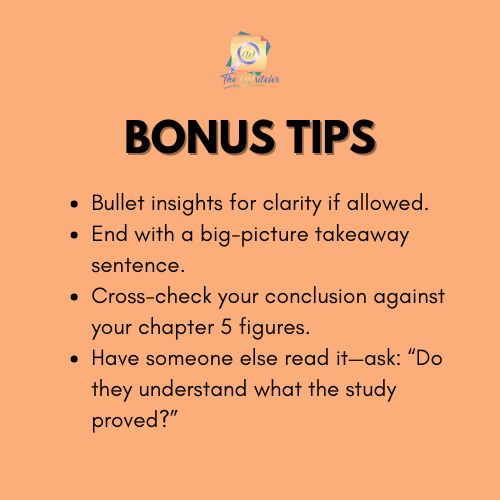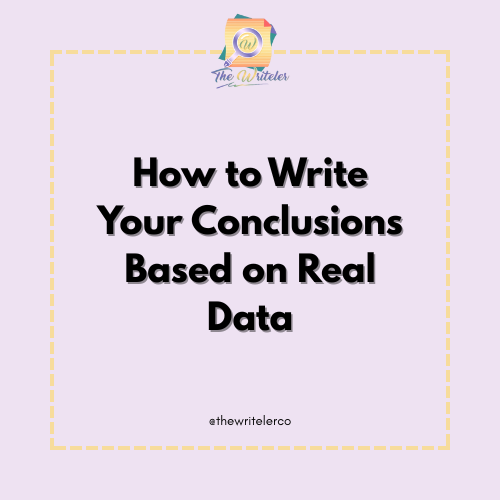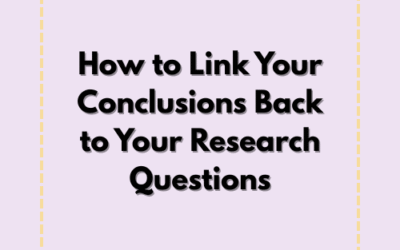When you’re wrapping up your research, the conclusion isn’t just a formality—it’s your mic drop. But too often, students and professionals write conclusions that are either too vague or too opinion-based. If you’re working on chapter 5 of your thesis or finishing a research report, it’s time to shift the narrative: Let your data do the talking.
In this guide, we’ll show you exactly how to write conclusions that are grounded in real data, including how to make chapter 5 strong, clear, and meaningful.
Why Chapter 5 Is Where Your Data Should Shine
Whether you’re writing a thesis or business report, chapter 5 is typically where the results and their interpretations come together. It’s not the place to speculate wildly or just summarize what’s already been said—it’s where you extract meaning from your data and draw real-world insights.
A data-driven conclusion builds trust. It shows:
- You understand your own work.
- You can interpret numbers into meaning.
- Your findings are worth listening to.
What’s the Purpose of a Data-Driven Conclusion?
Your goal is not just to say what you did, but to clarify:
- What the data reveals.
- What it doesn’t say.
- What it might imply for future research or action.
A good chapter 5 conclusion:
- Answers your research question directly.
- Refers to specific data or results (not in full detail, but briefly).
- Connects results to the bigger picture.
Start With Chapter 5’s Key Findings
Before you write anything, go back to your chapter 5 results and highlight:
- Trends or correlations.
- Surprising findings or contradictions.
- Any major statistics that support your hypothesis.
This will form the backbone of your conclusion.
🔍 Example: “As presented in Chapter 5, 72% of respondents reported increased productivity after using the AI writing tool, supporting the initial hypothesis that digital tools enhance content creation speed.”
How to Write a Solid Conclusion (Based on Chapter 5 Data)
1. Answer the Research Question Clearly
Don’t tiptoe around it. Start by directly answering your study’s main question, using the most important result from chapter 5.
✅ “Based on the findings in Chapter 5, the study concludes that gamified quizzes significantly improved student retention rates in Grade 8 classrooms.”
2. Summarize the Most Important Findings
Don’t overload. Stick to 2–3 major points. Reference your chapter 5 stats or insights briefly, without repeating the whole section.
✅ “Chapter 5 showed that participants who meditated daily scored 28% higher on focus assessments and reported 45% less stress.”
3. Interpret What the Data Means
This is where you become the narrator. Explain the significance—why these findings matter and how they connect to theory, policy, or real life.
✅ “These outcomes suggest that even short-term mindfulness interventions can offer measurable mental health benefits in workplace settings.”
4. Discuss Limitations of Chapter 5 Data
Show humility by acknowledging what your data cannot do.
✅ “While Chapter 5 results are promising, the small sample size limits generalizability across diverse industries.”
5. Recommend Next Steps
Your conclusion shouldn’t just be a dead end. Recommend further research or real-world applications.
✅ “Future studies may explore whether these trends hold over longer durations or in remote work environments.”
Writing Style Tips for Chapter 5 Conclusions
- Use active voice: “The data confirms…” is stronger than “It was confirmed by the data.”
- Be concise: Cut unnecessary filler—every word should serve the insight.
- Avoid exaggeration: Stick to what your data actually supports.
- Use bridging phrases to tie back to your earlier arguments:
- “As shown in Chapter 5…”
- “These findings support the hypothesis stated in Chapter 1…”
Real Examples of Chapter 5 Conclusions
📘 Academic Thesis (Social Sciences):
“Chapter 5 revealed a clear correlation between financial literacy and entrepreneurial interest among senior high students. This suggests that school-based programs can significantly influence youth-driven business activity, especially in underserved areas.”
🧪 Scientific Study:
“The controlled trial data in Chapter 5 indicate a 62% reduction in viral load with compound X. These results provide a foundation for Phase II clinical testing, though long-term effects remain uncertain.”
💼 Business Research:
“According to Chapter 5’s A/B testing, users who received personalized onboarding emails converted 33% faster. This indicates a strong case for personalized UX approaches in fintech platforms.”
Common Mistakes to Avoid in Chapter 5 Conclusions
❌ Restating the entire chapter
✅ Instead: Just extract the highlights and their implications.
❌ Being too emotional or vague
✅ Replace “This proves my theory!” with “The results support the proposed hypothesis, particularly in…”
❌ Ignoring limitations
✅ Own the scope of your findings. It builds credibility.
❌ Adding new data
✅ Conclusions are for interpreting, not introducing.
Extra Tips for Strong Data-Driven Conclusions

✍️ Need Help With Chapter 5 or Your Final Conclusions?
Let The Writeler Co. Do the Heavy Lifting
Whether you’re wrapping up your thesis or finalizing a research report, The Writeler Co. is here to help you:
- Rewrite or enhance Chapter 5 conclusions
- Transform raw data into clean, impactful summaries
- Edit for clarity, tone, and academic structure
- Provide expert feedback for your conclusion section
📩 Get your research across the finish line with precision and polish. Visit The Writeler Co. to learn more or submit your draft for review.
Final Thoughts: Your Data Deserves a Powerful Sendoff
Chapter 5 is the climax of your research—and your conclusion is the encore. It’s not just about restating results but interpreting them with confidence and showing readers why they matter.
Your study likely started with a question. Now you have the answer. And your conclusion is where you finally say it—loud, clear, and backed by data.





0 Comments